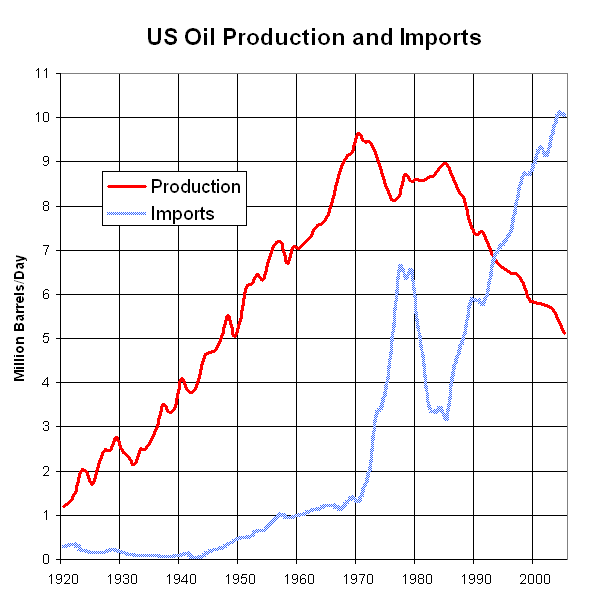- First U.S. Secretary of Energy James Schlesinger, describing American energy policy
For the past decade or so I have made a personal hobby out of following issues surrounding energy, especially oil. I have read countless news articles, opinion pieces and books -- as well as following it on other media such as podcasts and news shows. Since I have spent a considerable amount of time to inform myself on these matters, I am consistently left dumbfounded by the sheer ignorance exhibited by the political class, mainstream media and public-at-large regarding energy and oil.
I've gone ahead and labeled this post as "Part One," since I'm sure that this is a topic that I'll come back to revisit as events continue to unfold. It's simply too deep a topic to be covered in a single post.
MYTH NO. 1: America has plenty of oil to meet our (current and future) needs.
I should start this one with a caveat. If "needs" are defined as current trends extrapolated as growing at a continuous rate into the future, then this line of thought is absolute horseshit. American discoveries peaked around 1930 with the discovery of the West Texas fields, and around 1970 our domestic production peaked, just as legendary petroleum geologist Marion King Hubbert predicted in 1956. Although bringing the Alaskan North Slope into full production in the 1980s helped raise production, the US never again matched its peak production of around 9.5 million bbd.
Source: Jim Quinn, "Lies We Tell Ourselves," Naked Capitalism (http://www.nakedcapitalism.com/category/auto-industry), accessed March 10, 2011.
If anyone can look at the lines on this graph and explain with a straight face why we have not exploited these numerous sources of oil even as our reliance on imports has surged again over the past 25 years, please let me know -- I have a bridge connecting two of NYC's boroughs you might be interested in....
MYTH NO. 2: It's all those greedy speculators / oil companies!
Background for dispelling this myth can be found in point no. 1, as well as the following graph showing global oil discoveries and production.

Source: ASPO-USA, "Oil Discovery" (http://www.aspousa.org/index.php/peak-oil-reference/peak-oil-data/oil-discovery/), accessed March 10, 2011.
Recall from the rebuttal to myth no. 1 the lag time between discovery peak and production peak for the United States? Now, look at the time passed since global discovery peak on the above graph. The simple matter is that as supply and demand of any commodity -- be it wheat, gold, or as so comically shown in the moving "Trading Places," frozen concentrated orange juice -- begin to converge, the price of that commodity becomes much more open to extreme swings through speculative investment. As soon as speculation takes hold, the price begins to be driven more through emotion than anything else -- both on the upswing and on the downswing. It seems that people have already forgotten how quickly the price rose to $147 per barrel and subsequently crashed into the $30s only 2-3 years ago.
MYTH NO. 3: We should open up the Strategic Petroleum Reserve!
Merriam Webster defines "strategic" as:
2
b : required for the conduct of war and not available in adequate quantities domestically [strategic materials];
c : of great importance within an integrated whole or to a planned effect [strategic points];
3 : designed or trained to strike an enemy at the sources of its military, economic, or political power [strategic bomber]
Does a simple rise in the price of a commodity, no matter how precious that commodity is to conducting what we see as a "normal" life, meet any of the above definitions? Hardly.
MYTH NO. 4: There are plenty of oil reserves out there, we just have to start pumping them.
The keys to understanding oil supplies lies not in looking at simple reserve numbers, but rather looking at production and energy return on energy invested (ERoEI). For example, a field may contain reserves of 20 billion barrels. But if you can only produce 100,000 barrels each day without the possibility of damaging the well (and impacting future production), then your production is only 100,000 barrels each day.
As for ERoEI, the Canadian Tar Sands provides an excellent example. These finds may indeed contain billions of barrels of oil equivalent. They also take high amounts of energy to produce, with an estimated ERoEI of 5. This means that it costs approximately 1 barrel of oil equivalent to obtain 5 barrels of oil equivalent from the tar sands. By comparison, the West Texas fields had an ERoEI of over 50:1, in some instances approaching 100:1 (Note: I would like to provide a source for this last number, but I have read it in several places and can't readily find one with just a quick Googld search). What this means is that although there may be a lot of potential oil in the tar sands, it also takes a tremendous amount of oil to get at it. It's the equivalent of investing money toward the point that you only receive $1 for every $1 you put in -- at which point there's no longer any point in continuing. Likewise, regardless of the amount of projected reserves of tar sands, the difficult process in turning them into usable oil places a cap on the possible production well below that of light, sweet crude with an ERoEI of 50:1 and upwards.
I'll leave it at those 4 for right now. If anyone has any thoughts on this, I would appreciate hearing them. I'll probably return to this topic again in the future as more ideas come to me.

No comments:
Post a Comment